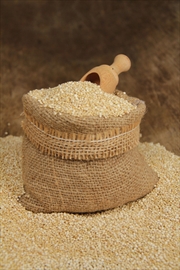
Americans spend a whopping $10.5 billion a year on gluten-free foods, including calorie bombs like zero-gluten cakes, pizza, fast-food fries and, new this year, gluten-free, chocolate-chip Girl Scout cookies.
But even as food marketers cater to the craze with so many unhealthful products, you should tune in to the fact that there are real benefits from reading the labels and going gluten-free or easy on gluten. (Hint: You’re going to want to dump all that processed, refined flour that shows up in cereals, breads, snacks and frozen meals in favor of tasty, nutrition-packed alternative grains and grain-like foods.)
What started this trend was the realization that at least 1.8 million Americans have celiac disease (it was underdiagnosed for a long time), an autoimmune disorder triggered by a mistaken immune system reaction to gluten proteins found in wheat, barley and rye.
If gluten is eaten, the reaction causes damage to the small intestine and malabsorption of nutrients, and can lead to osteoporosis, brain fog and other complications.
Another 18 million of you may have a gluten or wheat sensitivity that triggers headaches, tiredness, inflammation, joint pain and digestive discomfort.
There’s no test for this kind of intolerance. But if you’ve given up gluten and feel better, then stick with it.
And the rest of you? Whether gluten makes you feel bad or not, you can benefit from trying these amazing gluten-free strategies.
Replace some grains with veggies. Long before gluten-free foods hit the mainstream, people who avoided G-packed grains hit on a smart move: They ate sandwiches on slabs of lettuce instead of bread, served an extra veggie with dinner instead of rolls, and ladled pasta sauce over spaghetti squash or other veggies instead of noodles. Replacing refined grains (white bread, rolls, pasta, cereals) with veggies is a great way to get more fiber, vitamins, minerals and cell-protecting phytochemicals, and cut calories at the same time. (We think this is one reason why people who go G-free feel great and lose weight.)
Munch a new grain. You can hit your whole-grain quota (we recommend three to four servings a day) with delicious alternatives that deliver unique nutrition profiles. Tasty alternatives include:
Quinoa: Safe for people with celiac disease, this delicious side dish actually comes from the same vegetable family as beets and spinach. But it looks and eats like a grain, thanks to its tiny seeds packed with protein, fiber, B vitamins and iron. Quinoa has a mild, nut-like flavor, cooks up in 15 minutes, and is delicious with stir-fries, paired with chicken or fish, or as a base for your famous, secret-recipe spaghetti sauce.
Millet: In Chinese, the words for millet and mouth together make the word “harmony,” a nod to this grain’s popularity. Rich in polyphenols and in magnesium, millet cooks in 25 minutes. Its fluffy texture makes it a natural in pilafs or as a hot breakfast cereal. Toss it in soups and stews, or bake into bread, too.
Buckwheat: Like quinoa, buckwheat (also known as kasha) isn’t a true grain. It has long been prized in great cuisines around the world: as kasha in Eastern Europe, soba noodles in Asia, even in French pancakes. It contains blood-sugar-friendly soluble fiber, plus slow-digesting starches that help protect against colon cancer.
Amaranth: These tiny, protein-packed seeds cook in 15-20 minutes and never lose their crunch. They “pop” in your mouth, revealing a creamy texture within. Rich in protein, amaranth helps control cholesterol, too. Amaranth releases lots of starch as it cooks, creating a porridge-like consistency. Depend on this grain for breakfast, or add it to baked goods or soups.
Sorghum: Yup, you can eat it. Sorghum is packed with protein, iron and fiber. Widely eaten in India and Africa, you’re most likely to find it here as flour. Its starches digest slowly, which helps keep blood sugar lower and steadier, which is a good deal if you add it to healthy muffin or bread recipes.
Mehmet Oz, M.D. is host of “The Dr. Oz Show,” and Mike Roizen, M.D. is Chief Wellness Officer and Chair of Wellness Institute at Cleveland Clinic. To live your healthiest, tune into “The Dr. Oz Show” or visit www.sharecare.com.

